View in other NatureServe Network Field Guides
NatureServe
Montana
Utah
Wyoming
Idaho
Wisconsin
British Columbia
South Carolina
Yukon
California
New York
Wyoming Tansymustard - Descurainia torulosa
State Rank Reason (see State Rank above)
One collection from Park County, Montana (Consortium of Pacific Northwest Herbaria; http://www.pnwherbaria.org).
- Details on Status Ranking and Review
Population Size
ScoreA - 1 - 50 individuals
Range Extent
ScoreA - <100 sq km (< ~40 sq mi)
Area of Occupancy
ScoreA - 1 4-km2 grid cell
Number of Populations
ScoreA - 1 - 5
Number of Occurrences or Percent Area with Good Viability / Ecological Integrity
ScoreB - Very few (1-3) occurrences with excellent or good viability or ecological integrity
Environmental Specificity
ScoreC - Moderate. Generalist or community with some key requirements scarce
Long-term Trend
ScoreU - Unknown
Trends
ScoreU - Unknown
Threats
ScoreU - Unknown
CommentThreats: Unknown/undetermined.
Intrinsic Vulnerability
ScoreU - Unknown
General Description
PLANTS: Short-lived perennials, somewhat to densely hairy all over. Stems few to many, arising from the base, generally not branched below and very seldom branched above, decumbent (Goodson and Al-Shehbaz in FNA 2010), 4–15 cm. Vestiture of stellate hairs (Lesica 2012).
LEAVES: Basal leaves: rosulate; petiole 3-14 mm; blade oblanceolate, 9-35 mm in length, the 3-5 pairs of blade lobes oblong to oblanceolate with smooth margins (FNA 2010). Stem leaves lacking petiole or short-petiolate; blades reduced distally (FNA 2010), 2–10 cm in length, oblanceolate, pinnate, the pinnae lobed to entire (Lesica 2012).
INFLORESCENCE: Racemes, growing significantly longer in fruit (Goodson and Al-Shehbaz in FNA 2010).
Phenology
Flowers June-July (FNA 2010).
Diagnostic Characteristics
Descurainia torulosa has clearly distally-curved fruits, is slightly pubescent and strongly torulose. Its stems (often several) are decumbent and unbranched.
The fruit of the similar
Descuraina incana is straight, glabrous, and barely or not at all torulose. Its simple stems are erect and branched (Goodson and Al-Shehbaz
in FNA 2010).
Species Range
Montana Range
Range Descriptions
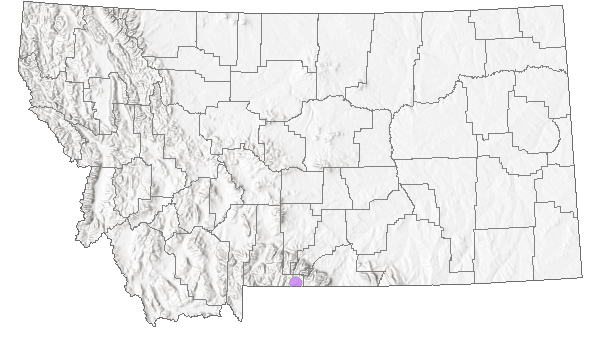
 Native
Native
Range Comments
Endemic to western Wyoming and Park County, Montana.
Observations in Montana Natural Heritage Program Database
Number of Observations: 1
(Click on the following maps and charts to see full sized version)
Map Help and Descriptions
Relative Density
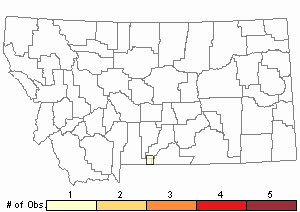
Recency
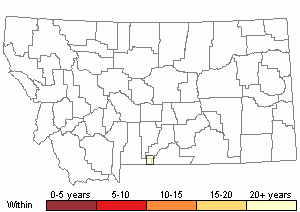
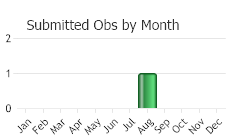

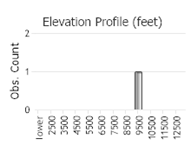 (Observations spanning multiple months or years are excluded from time charts)
(Observations spanning multiple months or years are excluded from time charts)
Habitat
Talus slopes in the subalpine zone within Montana (Lesica et al. 2012).
Reproductive Characteristics
Flowers: Sepals upright, somewhat yellow, hairy (Goodson and Al-Shehbaz in FNA 2010); petals yellow, 1–2 mm in length (Lesica 2012).
Fruit: Fruit clearly curved distally, slightly pubescent, erect or nearly (Goodson and Al-Shehbaz in FNA 2010), torulose (with bulges around and constrictions between the seeds), 6–15 mm in length, up to 1 mm in width, tapering at both ends; style 0.1–0.3 mm in length. Seeds 10 to 18 per locule in 1 row (Lesica 2012), reddish brown; pedicels upright or nearly so, straight, 1.5-3 mm in length (Goodson and Al-Shehbaz in FNA 2010).
Stewardship Responsibility
Threats or Limiting Factors
STATE THREAT SCORE REASON
Reported threats to Montana’s only population of Wyoming Tansymustard are due to invasive species (MTNHP Threat Assessment 2021). Direct competition and declining habitat quality are reported to have moderate to serious negative impacts.
References
- Literature Cited AboveLegend:
 View Online Publication
View Online Publication Flora of North America Editorial Committee, eds. 2010. Flora of North America North of Mexico. Volume 7. Magnoliophyta: Salicaceae to Brassicaceae. Oxford University Press, Inc., NY. 832 pp.
Flora of North America Editorial Committee, eds. 2010. Flora of North America North of Mexico. Volume 7. Magnoliophyta: Salicaceae to Brassicaceae. Oxford University Press, Inc., NY. 832 pp. Lesica, P., M.T. Lavin, and P.F. Stickney. 2012. Manual of Montana Vascular Plants. Fort Worth, TX: BRIT Press. viii + 771 p.
Lesica, P., M.T. Lavin, and P.F. Stickney. 2012. Manual of Montana Vascular Plants. Fort Worth, TX: BRIT Press. viii + 771 p. MTNHP Threat Assessment. 2021. State Threat Score Assignment and Assessment of Reported Threats from 2006 to 2021 for State-listed Vascular Plants. Botany Program, Montana Natural Heritage Program, Helena, Montana.
MTNHP Threat Assessment. 2021. State Threat Score Assignment and Assessment of Reported Threats from 2006 to 2021 for State-listed Vascular Plants. Botany Program, Montana Natural Heritage Program, Helena, Montana.
- Additional ReferencesLegend:
 View Online Publication
View Online Publication
Do you know of a citation we're missing? Lesica, P., M.T. Lavin, and P.F. Stickney. 2022. Manual of Montana Vascular Plants, Second Edition. Fort Worth, TX: BRIT Press. viii + 779 p.
Lesica, P., M.T. Lavin, and P.F. Stickney. 2022. Manual of Montana Vascular Plants, Second Edition. Fort Worth, TX: BRIT Press. viii + 779 p.
- Web Search Engines for Articles on "Wyoming Tansymustard"





